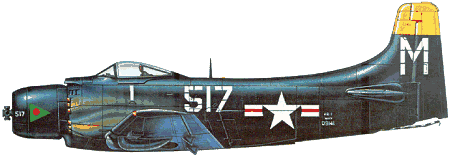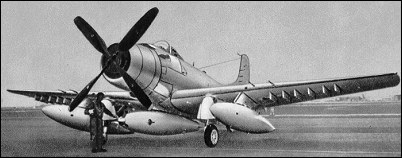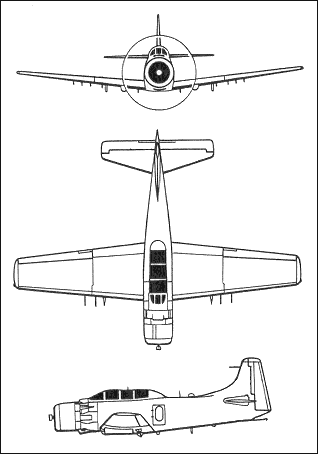|
| Developed to satisfy a US Navy requirement of 1944 for a single-seat carrier-based dive bomber and torpedo carrier, the Douglas AD Skyraider (as it became designated) materialised too late for operational service in World War II. Ordered into production alongside the Martin AM Mauler, which had been developed to meet the same specification, it was to continue in production until 1957; although Martin's aircraft was taken off the production line after 151 had been built.
The Skyraider reflected the navy's wartime experience gained in the Pacific theatre, where it had been proved that the most important requirement for such aircraft was the ability to carry and deliver a heavy load of assorted weapons. Of low-wing monoplane configuration, a big Wright R-3350 radial engine was selected as the most suitable power plant to meet the load-carrying requirement, and this more or less dictated the fuselage proportions. The prototype XBT2D-1 flew for the first time on 18 March 1945. When production terminated 12 years later 3,180 aircraft had been built in many variants.
Although too late for World War II, Skyraiders were successfully deployed in both the Korean War and in Vietnam. Steady development led to the introduction of new power plant and equipment and the AD-5 was one of the most versatile military aircraft in US service. It differed significantly from earlier versions by having a wider and lengthened fuselage and providing side-by-side seating for two crew; specially designed quick-change kits were available so that the basic AD-5 could be utilised as a 12-seat transport, as well as for freight-carrying, ambulance and target-towing roles. When the US tri-service designations were rationalised in 1962, AD-1 to AD-7 versions became redesignated from A-1A to A-1J.
In addition to serving with the US Navy, Skyraiders have been operated also by the USAF and with the Royal Navy, French and Vietnamese Air Forces among others.

| MODEL | AD-7 (AD-1J) |
| ENGINE | 1 x Wright R-3350-26WA, 1985kW |
| WEIGHTS |
| Take-off weight | 11340 kg | 25001 lb |
| Empty weight | 4785 kg | 10549 lb |
| DIMENSIONS |
| Wingspan | 15.47 m | 51 ft 9 in |
| Length | 11.84 m | 39 ft 10 in |
| Height | 4.78 m | 16 ft 8 in |
| Wing area | 37.16 m2 | 399.99 sq ft |
| PERFORMANCE |
| Max. speed | 515 km/h | 320 mph |
| Ceiling | 7740 m | 25400 ft |
| Range | 1448 km | 900 miles |
| ARMAMENT | 4 x 20mm cannon, 3629kg of bombs |
| Les Locklear, e-mail, 15.12.2022 17:10 During the Cuban Blockade I was a BT3 on the Independence. I was on leave when the Indy left Norfolk early for the Cuban blockade. I returned to Norfolk and spent the night in a dorm. The next morning a group of about 11 of us were flown down to Mayport to be picked up by the Indy's planes. I got into the seat next to the pilot of a AD5Q with a couple more sailors in the rear cockpit seats. Quite a landing...I think I left some of my skivvies on the seat. Taxied to the island, grabbed my awol bag and went below to the living quarters. When I walked in, the compartment PO said, "where in the hell did you come from?" I told him they sent a plane to Duluth, Minnesota to pick me up as they were shorthanded. I made the first 4 Med cruises and got out September 1964 as a BT2. Great memories. reply | | Les Locklear, e-mail, 15.12.2022 17:09 During the Cuban Blockade I was a BT3 on the Independence. I was on leave when the Indy left Norfolk early for the Cuban blockade. I returned to Norfolk and spent the night in a dorm. The next morning a group of about 11 of us were flown down to Mayport to be picked up by the Indy's planes. I got into the seat next to the pilot of a AD5Q with a couple more sailors in the rear cockpit seats. Quite a landing...I think I left some of my skivvies on the seat. Taxied to the island, grabbed my awol bag and went below to the living quarters. When I walked in, the compartment PO said, "where in the hell did you come from?" I told him they sent a plane to Duluth, Minnesota to pick me up as they were shorthanded. I made the first 4 Med cruises and got out September as a BT2. Great memories. reply | | PAUL L COCHRAN, e-mail, 24.07.2022 21:09 I served with VAW-13 as an engine mechanic maintaining the AD-5Q aircraft. I am looking for information concerning an AD-1 aircraft that returned from a mission over North Vietnam with severe aircraft damage to the cockpit and right side of the engine. I thought it might have been an aircraft from the USS Oriskany but have not been able to find any supportive information. I was on the flight deck as aircraft returned from their mission and one was missing a A-1 and the flight deck was about to be respotted when black smoke was spotted in the distance and sure enough it was the A-1. After landing it taxed up to the forward right had cat and shut down. To everyone's amazement the cockpit was all shot up and the right side of the engine had cowling shot off, some cylinder heads shot away along with the exhaust stacks. The pilot emerged with only minor cuts but pretty well shaken up. I would like any information or pictures if anyone else witnessed this as I did not have a camera at the time! I just cannot remember what carrier it was around Oct-November 1966! reply | | Mike Stanton, e-mail, 14.06.2021 04:09 As a NAVCAD I flew the AD-1 in flight schools in Pensacola and Corpus Christi, My first flight in AD-1 Bu 09112 was on March 28, 1952. My last flight was Carrier Quals on the USS Cabot on July 30, 1952 flying AD-1 Bu 09235. At the conclusion of this flight I was designated an Ensign and reported to VA-728 (later redesignated as VA-155) at Moffett Field. Deployed on the USS Princeton, CVA-37 to Korea in AD-4NA. Flew 48 missions. Wonderful aircraft by Douglas reply | |
| | Tom Lull, e-mail, 09.01.2016 05:24 Philip Oakley Question: The plates you mention restricted air flow into the engine area for cold weather starts. Some times the exhaust for a huffer was vented into the compartment to keep the oil fluid enough to start. They would open when the engine temps became normal. reply | | Philip Oakley, e-mail, 01.01.2016 17:55 I recently visited the Pensacola museum and noticed what appeared to be hinged "plates" inside the cowling on their Skyraider. They would seem to block airflow to the engine. Can anyone tell me their purpose? reply | | Howard L New AZC USN RET, e-mail, 29.07.2015 23:35 My correct E-mail is howardlnew@gmail.com reply | | Dean Cook, e-mail, 21.04.2015 21:37 Was in VAW13 Agana,Guam from 1959 to June of 1961. Was an AE Airman. Was on the Midway, The Kearsarge,and the Coral Sea and the Hornet. Heard that this AD5W Guppy is a lot like the P46 from WWII. reply | | Bob Sullivan, e-mail, 11.04.2015 20:33 I went thru training on Skyraiders & Nukes in 1962 with VA 122 at Moffit field Ca. then transferred to VA 25 & we moved to Lemoore NAS & then made 2 cruises on the USS Midway 63 /64 & 1965 10 mo.Tonkin Gulf we had AD-6 & 7's the Eng.ADI was lock wired closed. I noticed that one fellow wanted to know access for electronics etc- there was a hatch under the belly about even with the rt trailing edge flap, I rode in there many times on compass swings, VA 25 had a confirmed Mig 17 kill in June of 65 (history channels "gun kills of Vietnam")& later we launched a skraider with a Toilet under the rt wing - just Google _ "VA 25 Toilet Bomb" to see video & still pictures, if you notice those bombs next to the toilet are 500 lb , that was normal load with a 1000 lb on center station. Bob Sullivan AE-3 reply | | Louis Vega, e-mail, 03.04.2015 09:39 Worked on the engines on A1Es from 10 /64 to 10 /65 at Bien Hoa in Viet Nam, great plane but at times hard to change cylinders, due to engine configuration, still, the r3350 engine was allmost as powerfull as the r4360 witch was used on the KC97s..
This airplane could take a lickin, but kept right on flying... reply | | George H. Wimer, e-mail, 27.03.2015 02:53 I was a plane captain on an AD-6 with Attack Squadron 85 aboard USS Forestall in 1962-1963 Med. cruise. What a fun time we had until the Cuban missile crises broke out. We left port in the middle of the night. reply | | Fred Volpe, e-mail, 19.02.2015 00:34 I have a B&W picture of an AD6 on the flight deck of the USS Coral Sea CV43?? Part of VMA333 probably taken in 1955 or 1956 somewhere in the Atlantic off Mayport. Fred Volpe reply | | Jack Fennel, e-mail, 27.01.2015 03:21 I have a squadron patch from VA-215 circa 1960 Seems that is what Ralph is looking for. If that is correct he can contact me via e-mail reply | | Owen, e-mail, 15.01.2015 22:37 Mr Johnsen,
I am employed at Battleship Park in Mobile, AL where the SPAD you will soon visit resides. Sir, what squadrons did you serve with in Korea?
v /r,
Owen Miller reply | |
| | soumakischris, e-mail, 07.08.2014 23:04 I need your help as seen in the ZM Skyraider behind the fuel tank there are some electronics and radios how were they accessed ?
What panel was opened to maintain them. any reference photos need
The AD7 has no doors at the side reply | | Ralph Koslin, e-mail, 02.02.2014 19:17 Greetings,
I am looking for old USNR and USMCR Squadron patches from the 1950's and 1960's. If you have only one patch, I would be happy to reproduce the patch + send a new hard-cover book on the Able Dog. An embroidery shop with a loom, can spin an EXACT reproduction of the patch - same size, design, and colors. I would like to keep the original patch for my collection.
I have almost twenty pre-1970 USNR Fighter and Attack Squadron patches in my collection. I also have a handful of older USMCR patches.
I would be happy to send you, a new hard-cover book about the A.D. The book was written by a former A.D. pilot. The book also covers AD operations in Korea.
Please kindly look for an old patch at your leisure. I would send the book to you up-front / (BEFORE) any patch is mailed to me. Thanks for your interest.
Ralph reply | | Roy M. Johnsen, e-mail, 18.01.2014 23:09 Glad to see this row of comments and find Ken Wachtel who was once a crewman sitting behind me in the AD-3W with VC-12 at Qonset. Made several deployments from '53 to '57. reply | | John Webster(GMT1), e-mail, 23.12.2013 23:23 I was transferred to VA-122 RAG in the fall of 63. Just after it moved from Moffet Field. I attended the last weapons loading class there headed up under AO Chief Edsel M. horne.
I really enjoyed NAS Lemoore. As a GMT, I was assigned to the RAG's weapon loading school & helped train both EM & officers. The Vietnam was heating up & it helped extend the lift of the "SPAD" before it morf'ed into a more modern aircraft. There was a few nuclear weapons specialist, but I worked mostly with AO's. We shared the training building with VA-122 training personnel. What a trip!!! reply | | Fred Kattelman, e-mail, 22.10.2013 22:03 We learned how to Ground handle /service /pre-flight /turn-up /run through "check sheets" /throttle-fuel mix-- mag drop settings ect.on ADs [Skyraiders]at ADR"A"school Flightline NATTC Memphis,Grad. spring 1963.[anyone have any ADR-class Photos?]Later 1963 to 5 at Nas Alameda Flightline ,Aircraft Maint.What a Aircraft!!Learned that 6 "reel Type" Tiedowns wont hold a "Spad"back when you pull the prop into "Full Pitch"during a power check out / run up,I think I was airborne for 30 feet or so before I pulled back to Idle cutoff,I had lots of tarmac to slow down on ,and didnt suffer "sudden stopage"---------Every turnup after that had full hydro pressure "CHAIN TIEDOWNS" secured tight[First]!!!!!. Thanks --Ill shut up now!!!!Fred Kattelman---EX-- [ADR-3] reply | | Ben Ardanowski, e-mail, 16.08.2013 22:52 I flew with VAW-13 1962-1964 Did the back seat and 7 Aircraft Carriers. Did the front seat with the Skipper in
Alameda and some gunnery practice off Cubi. I loved the job.
Finished up with 12 years as an IFT with the P-3. Orion. Last flight at age 52. Aviation was a right choice for me. reply |
|
Do you have any comments?
|
| 
COMPANY
PROFILE
All the World's Rotorcraft
|








